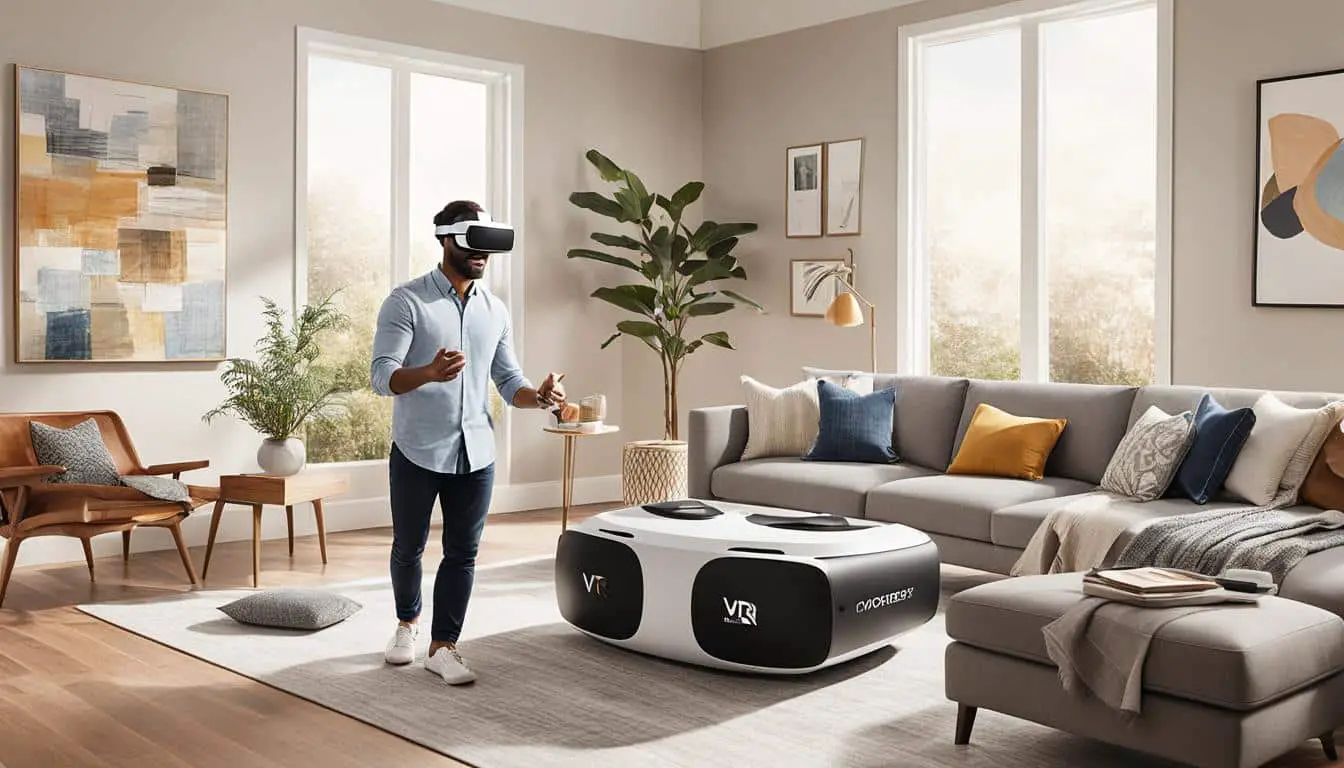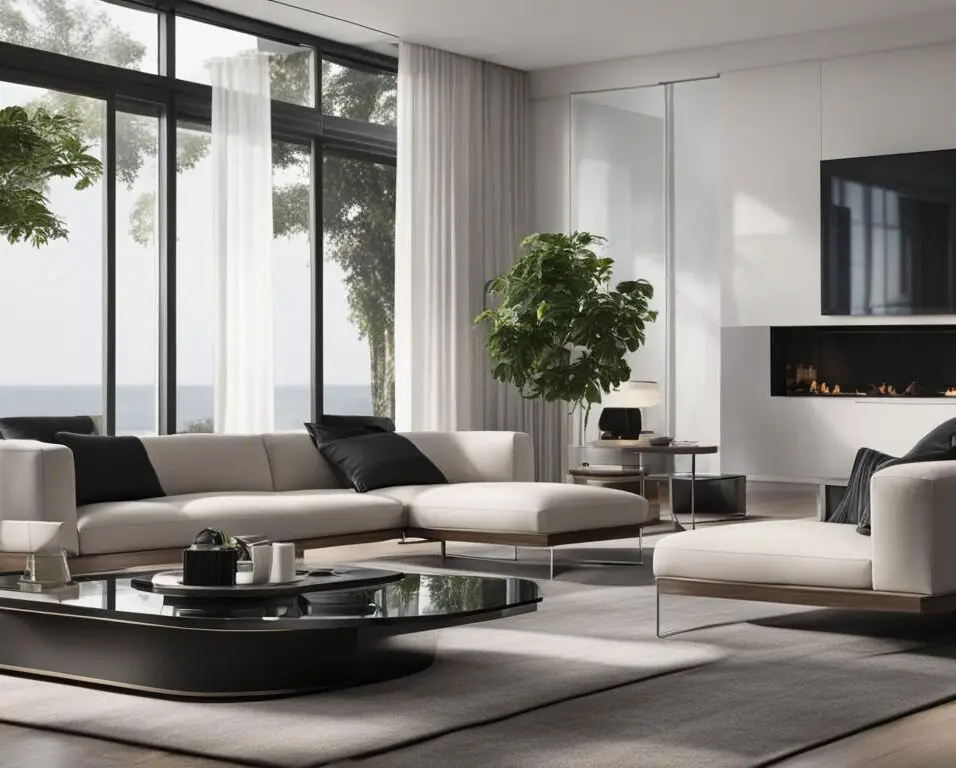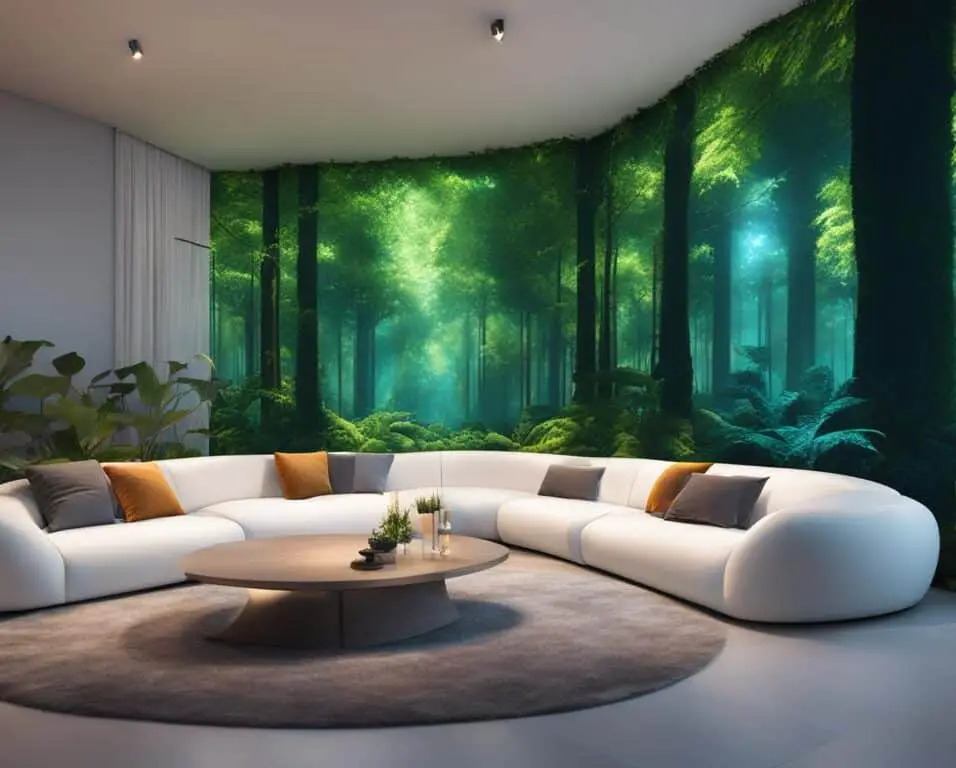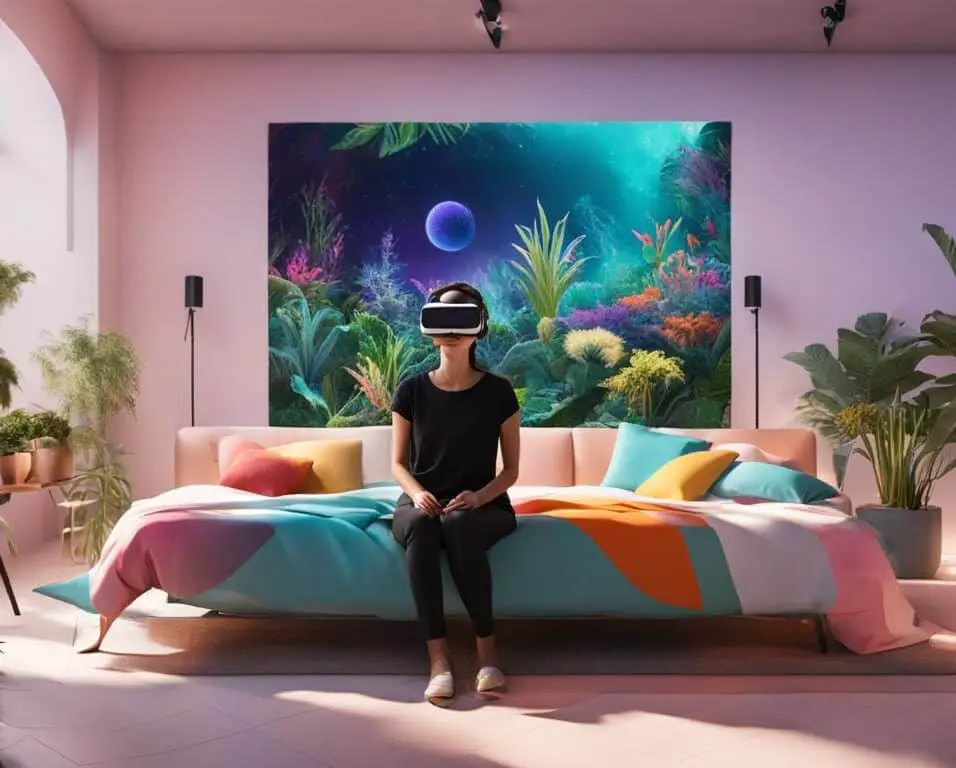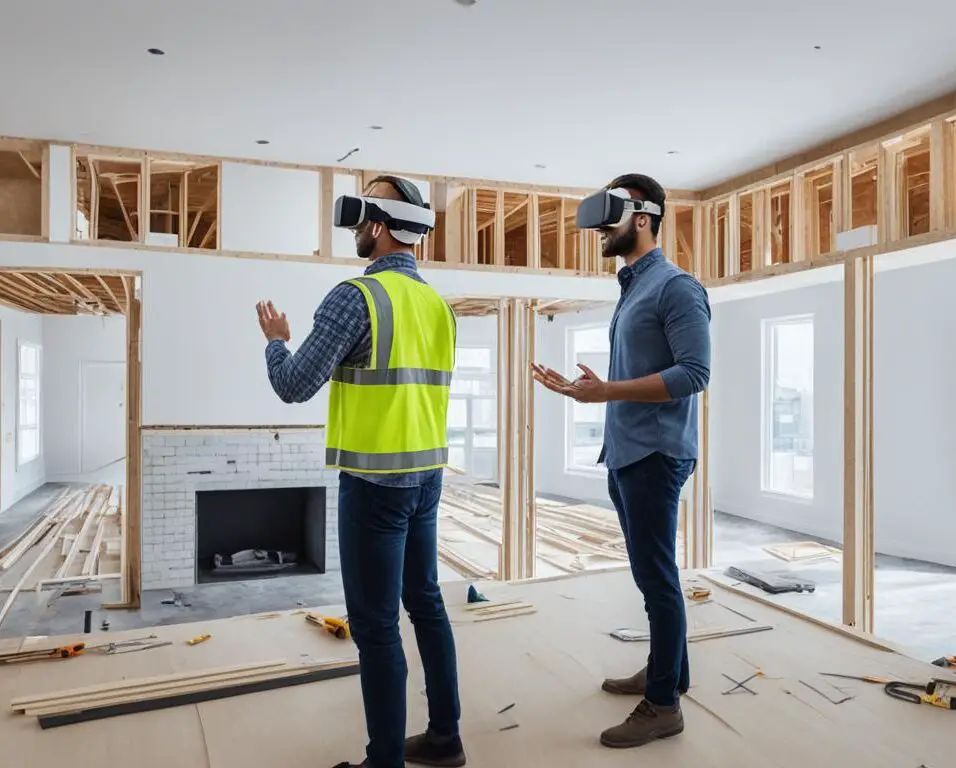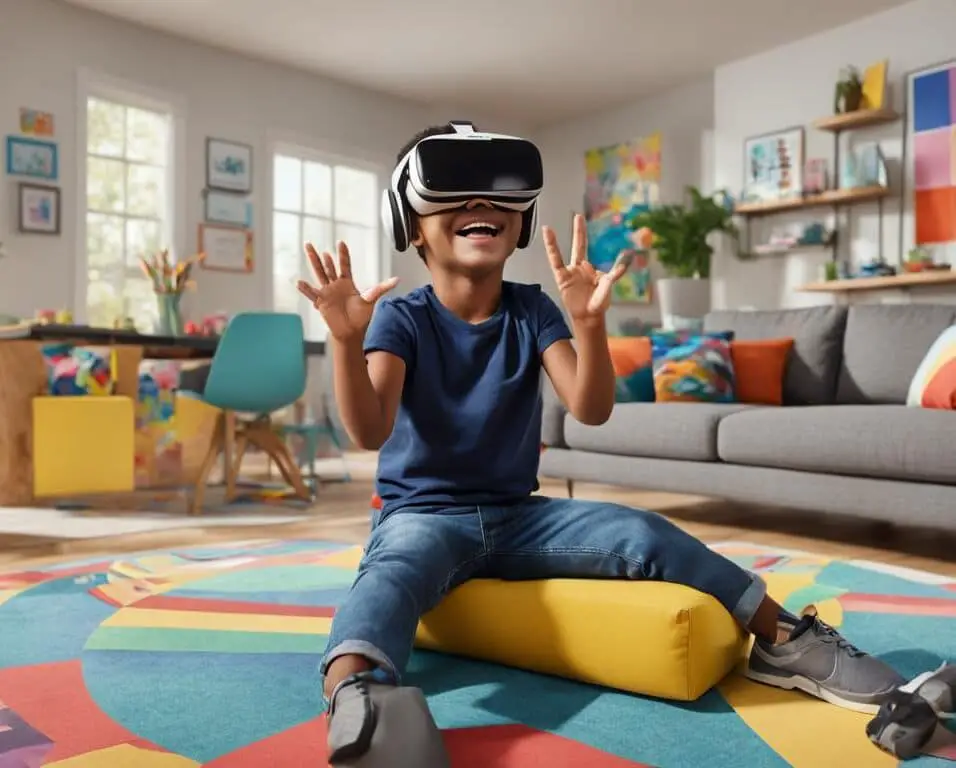Engaging Spaces: VR for Client Engagement in Home Projects
Virtual reality (VR) technology is transforming the way clients interact with home projects. Through immersive design visualization, VR enhances client engagement and brings projects to life. With the help of AI and cutting-edge technologies, VR allows clients to experience their future spaces before construction begins, leading to impressive outcomes and higher client satisfaction.
In the world of home design, VR offers a powerful tool for design visualization. By creating a virtual environment, clients can explore their future spaces in a fully immersive and interactive way. They can walk through virtual rooms, visualize different design options, and even experience how natural light will affect the space at different times of the day. This level of detail and realism enhances client engagement, allowing them to make informed decisions and provide valuable feedback before construction begins.
Not only does VR technology transform client interactions, but it also revolutionizes the entire design process. Architects and designers can collaborate with clients in real-time, making design changes on the spot and receiving immediate feedback. This interactive approach fosters a collaborative environment, where clients feel empowered and involved in the decision-making process. VR also allows clients to visualize and understand design concepts more easily, leading to clearer communication and a more efficient design process.
The benefits of VR in home projects are numerous. Firstly, it improves communication between architects, designers, and clients, as they can all see and experience the same virtual space. This eliminates misinterpretations and misunderstandings, leading to a smoother design process. Secondly, VR allows clients to have a sense of ownership and connection to their future spaces, increasing their emotional investment in the project. This leads to higher client satisfaction and a stronger client-designer relationship.
The future of VR in home projects looks promising. Advancements in technology will make VR experiences even more realistic and immersive, offering more accurate and detailed design visualization. The integration of AI and other emerging technologies will further enhance the capabilities of VR, providing clients with an even more interactive and personalized experience. As VR becomes more accessible and affordable, it is expected to become a standard tool in the home design industry, transforming the way projects are conceptualized and implemented.
In conclusion, VR technology is revolutionizing client engagement in home projects. By offering immersive design visualization and enhanced communication, VR enhances the overall design process and leads to impressive outcomes. Embracing VR for client engagement in home projects is a step towards creating engaging spaces and ensuring client satisfaction.
Key Takeaways:
- VR technology enhances client engagement in home projects through immersive design visualization.
- Clients can explore their future spaces in a fully immersive and interactive way using VR.
- VR transforms client interactions, fostering a collaborative environment in the design process.
- Improved communication and a stronger client-designer relationship are among the benefits of VR in home projects.
- The future of VR in home projects will bring even more realistic and immersive design experiences.
The Power of Virtual Reality for Design Visualization
Virtual reality (VR) is an incredibly powerful tool that has transformed the way design visualization is done in home projects. By creating a virtual environment, VR allows clients to fully immerse themselves in their future spaces and interact with them in ways that were previously unimaginable. With VR, clients can walk through virtual rooms, explore different design options, and even experience how natural light will fill their space at different times of the day. This level of detail and realism provided by VR enhances client engagement, enabling them to make informed decisions and provide valuable feedback before construction begins.
The immersive experience of VR design visualization brings home projects to life in a way that traditional 2D renderings and blueprints simply cannot match. It allows clients to truly understand and visualize the spatial relationships, proportions, and materiality of their future spaces, leading to more accurate design decisions. Whether it’s testing different furniture arrangements, experimenting with various color palettes, or understanding how the flow of natural light can transform a room, VR offers an unparalleled level of realism and interactivity.
“VR design visualization has completely changed the way we engage with clients. It allows us to bridge the gap between their imagination and our design concepts, giving them a truly immersive experience and the confidence to move forward with their projects.” – Mark Johnson, Architect
Moreover, VR design visualization also improves communication and collaboration between architects, designers, and clients. The ability to experience and interact with a shared virtual space ensures that all parties involved are on the same page and have a clear understanding of the design intent. It eliminates misinterpretations and misunderstandings that often arise from traditional forms of communication, resulting in a smoother design process and fewer revisions.
Not only does VR design visualization enhance the client experience, but it also benefits professionals in the industry. Architects and designers can more effectively present their design concepts and ideas, allowing clients to fully grasp the vision and intent behind their proposals. They can showcase the unique features, highlight the aesthetic qualities, and demonstrate the functionality of their designs in a way that traditional presentations simply cannot achieve.
Overall, virtual reality has revolutionized design visualization in home projects, offering an immersive and interactive experience that improves client engagement, communication, and decision-making. The power of VR to bring spaces to life and create a strong emotional connection between clients and their future homes is unparalleled. As technology continues to advance and VR becomes more accessible, its impact on the design industry will only grow, shaping the way we envision and bring projects to fruition.
Transforming Client Interactions with VR Technology
VR technology has revolutionized client interactions in home projects, transforming the design process into a more interactive and collaborative experience. Architects and designers can now engage with their clients in real-time, allowing for immediate design changes and feedback. This interactive approach fosters a sense of empowerment and involvement for clients, making them an integral part of the decision-making process.
By utilizing VR technology, clients are able to visualize and understand design concepts more easily. The immersive nature of VR allows them to explore virtual spaces, test different design options, and gain a comprehensive understanding of how the final project will look and feel. This level of clarity leads to clearer communication between all parties involved and ultimately streamlines the design process.
The interactive design process facilitated by VR technology not only improves client satisfaction but also enhances the overall quality of the final design. By actively participating in the decision-making process, clients can provide valuable feedback and insights, resulting in a design that truly meets their needs and preferences.
“VR technology creates an environment where clients can actively engage with the design process. This level of collaboration and interactivity leads to higher client satisfaction and better outcomes.” – Sarah Thompson, Architect
It is important to note that VR technology not only benefits clients but also architects and designers. By having clients actively participate in the design process, potential misunderstandings or misinterpretations can be resolved in real-time, saving valuable time and resources.
Overall, the use of VR technology has transformed client interactions in home projects, creating a more engaging and interactive design process. Through this technology, architects, designers, and clients can collaborate effectively, resulting in a more efficient and satisfying design experience.
The Benefits of VR for Client Engagement in Home Projects
When it comes to home projects, incorporating virtual reality (VR) technology provides numerous benefits for enhancing client engagement. VR not only improves communication between architects, designers, and clients but also fosters a stronger connection to the future space, leading to higher levels of satisfaction and a more collaborative client-designer relationship.
One of the key advantages of VR in home projects is its ability to facilitate clearer communication. By enabling all stakeholders to see and experience the same virtual space, VR eliminates misinterpretations and misunderstandings that often arise from traditional design presentations. This shared experience fosters a smoother and more efficient design process, ensuring that everyone is on the same page from the start.
Additionally, VR allows clients to have a heightened sense of ownership and connection to their future spaces. By immersing themselves in realistic, interactive virtual environments, clients can visualize and experience their designs in a way that traditional blueprints or 3D models cannot replicate. This emotional investment leads to increased client satisfaction, as they feel more confident in their design choices and can truly imagine themselves living in the space.
VR technology not only enhances client engagement but also creates a transformative design experience that brings home projects to life. By immersing clients in a virtual world, we can tap into their emotions and aspirations, allowing for a more personalized and meaningful design journey. – Elizabeth Johnson, Interior Designer
Furthermore, VR technology strengthens the client-designer relationship by promoting collaboration and active involvement throughout the design process. With VR, clients have the opportunity to provide immediate feedback, make design decisions in real-time, and actively participate in shaping their future spaces. This collaborative approach empowers clients and ensures that their preferences and needs are effectively incorporated into the final design.
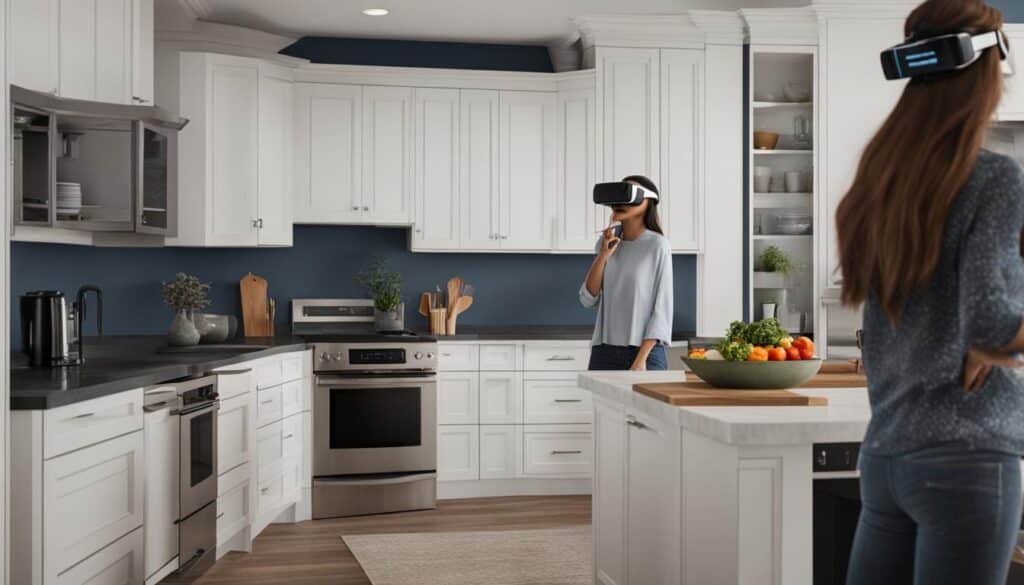
| Benefits of VR for Client Engagement in Home Projects | Enhanced Communication | Sense of Ownership and Connection | Stronger Client-Designer Relationship |
|---|---|---|---|
| Improved communication between stakeholders, leading to a smoother design process | Clients can see and experience the same virtual space, eliminating misinterpretations | Clients develop a sense of ownership and emotional connection to their future spaces | Collaborative approach strengthens the relationship and ensures client preferences are considered |
| Facilitates real-time feedback and decision-making | VR immerses clients in realistic virtual environments, enhancing visualization | Increases client satisfaction and confidence in design choices | Active client involvement leads to a more personalized and meaningful design journey |
| Promotes active client involvement and participation | Eliminates misunderstandings and improves design accuracy | Empowers clients to actively shape their future spaces | Client preferences and needs are effectively incorporated into the final design |
By leveraging the benefits of VR technology in home projects, architects and designers can create a more engaging and collaborative design experience. As VR continues to advance, we can expect it to play an increasingly vital role in the industry, revolutionizing the way we conceptualize and bring home projects to life.
The Future of VR in Home Projects
The future of VR in home projects is filled with exciting possibilities. As technology continues to advance, VR experiences will become even more realistic and immersive, providing clients with an unparalleled level of design visualization. The integration of AI and other emerging technologies will further enhance the capabilities of VR, allowing for more interactive and personalized experiences.
Imagine being able to step into a virtual version of your future home, where you can walk through each room, interact with objects, and see how different design choices impact the space. With VR, clients will have a better understanding of their home projects, enabling them to make informed decisions and provide valuable feedback.
“The future of VR in home projects is all about empowering clients and creating immersive experiences that capture their vision.”
With the increasing accessibility and affordability of VR, it is expected to become a standard tool in the home design industry. Architects, designers, and clients will be able to collaborate more effectively, breaking down communication barriers and ensuring that everyone involved is on the same page.
The Advantages of VR in Home Projects
VR offers numerous advantages for home projects:
- Accurate design visualization: VR allows clients to see their future spaces with unprecedented accuracy, enabling them to make informed decisions about design choices.
- Enhanced communication: By experiencing the same virtual environment, architects, designers, and clients can communicate more effectively, reducing misunderstandings and improving collaboration.
- Efficient decision-making: VR enables clients to explore different design options and see the impact of their choices in real-time, streamlining the decision-making process.
- Emotional connection: Immersive VR experiences create a sense of ownership and connection to the future space, increasing client satisfaction and attachment to the project.
The Future is Now
The future of VR in home projects is not a distant dream, but a reality that is gradually unfolding. As VR technology continues to evolve, the possibilities for creating engaging and immersive spaces are limitless. The home design industry is embracing VR wholeheartedly, recognizing its potential to transform the way projects are conceptualized and implemented.

With every advancement in VR technology, we move closer to seamlessly bridging the gap between imagination and reality. The future holds a world where clients can step into their dream homes before construction even begins, making decisions with confidence and excitement. The immersive technologies of VR are shaping the future of home projects, and the possibilities are truly awe-inspiring.
| Advantages of VR in Home Projects | Description |
|---|---|
| Accurate design visualization | VR allows clients to see their future spaces with unprecedented accuracy, enabling them to make informed decisions about design choices. |
| Enhanced communication | By experiencing the same virtual environment, architects, designers, and clients can communicate more effectively, reducing misunderstandings and improving collaboration. |
| Efficient decision-making | VR enables clients to explore different design options and see the impact of their choices in real-time, streamlining the decision-making process. |
| Emotional connection | Immersive VR experiences create a sense of ownership and connection to the future space, increasing client satisfaction and attachment to the project. |
Conclusion
In conclusion, VR technology is revolutionizing client engagement in home projects. By offering immersive design visualization and enhanced communication, VR enhances the overall design process and leads to impressive outcomes. With the ability to create virtual environments, clients can now explore their future spaces in a fully interactive and realistic way.
VR allows clients to walk through virtual rooms, visualize different design options, and experience how natural light will affect the space – all before construction even begins. This level of detail and realism not only enhances client engagement but also enables them to make informed decisions and provide valuable feedback. As a result, the final outcome of the project is more likely to meet their expectations.
The continuous evolution and increasing accessibility of VR technology are expected to make it a staple tool in the home design industry. Architects, designers, and clients will collaborate more effectively, transforming the way home projects are conceptualized and implemented. Embracing VR for client engagement is a step towards creating engaging spaces and ensuring client satisfaction.
FAQ
How does VR technology enhance client engagement in home projects?
VR technology enhances client engagement in home projects by providing immersive and realistic design visualization. Clients can explore their future spaces in a fully immersive and interactive way, making informed decisions and providing valuable feedback before construction begins.
How does virtual reality contribute to design visualization in home projects?
Virtual reality creates a virtual environment where clients can walk through virtual rooms, visualize different design options, and experience how natural light will affect the space. This level of detail and realism enhances client engagement and allows for better decision-making in the design process.
How does VR technology transform client interactions in home projects?
VR technology transforms client interactions by enabling real-time collaboration between architects, designers, and clients. Design changes can be made on the spot, allowing for immediate feedback and fostering a collaborative environment where clients feel empowered and involved in the decision-making process.
What are the benefits of using VR in home projects?
The use of VR in home projects improves communication between stakeholders, eliminates misinterpretations, and enhances client satisfaction. Clients have a sense of ownership and connection to their future spaces, leading to a stronger client-designer relationship and a smoother design process.
What does the future hold for VR in home projects?
The future of VR in home projects looks promising, with advancements in technology making VR experiences even more realistic and immersive. Integration with AI and other emerging technologies will further enhance the capabilities of VR, providing clients with an even more interactive and personalized design experience.



